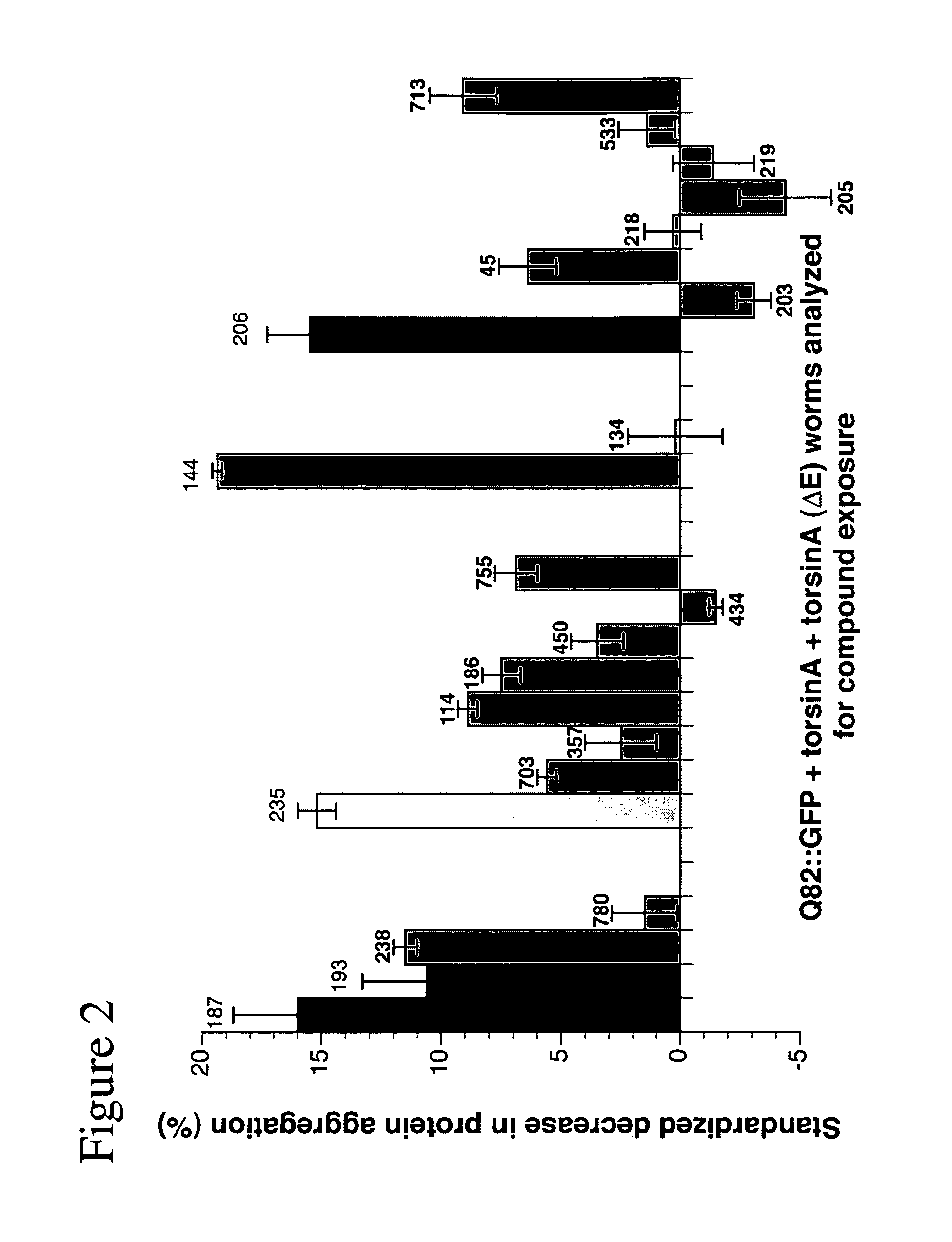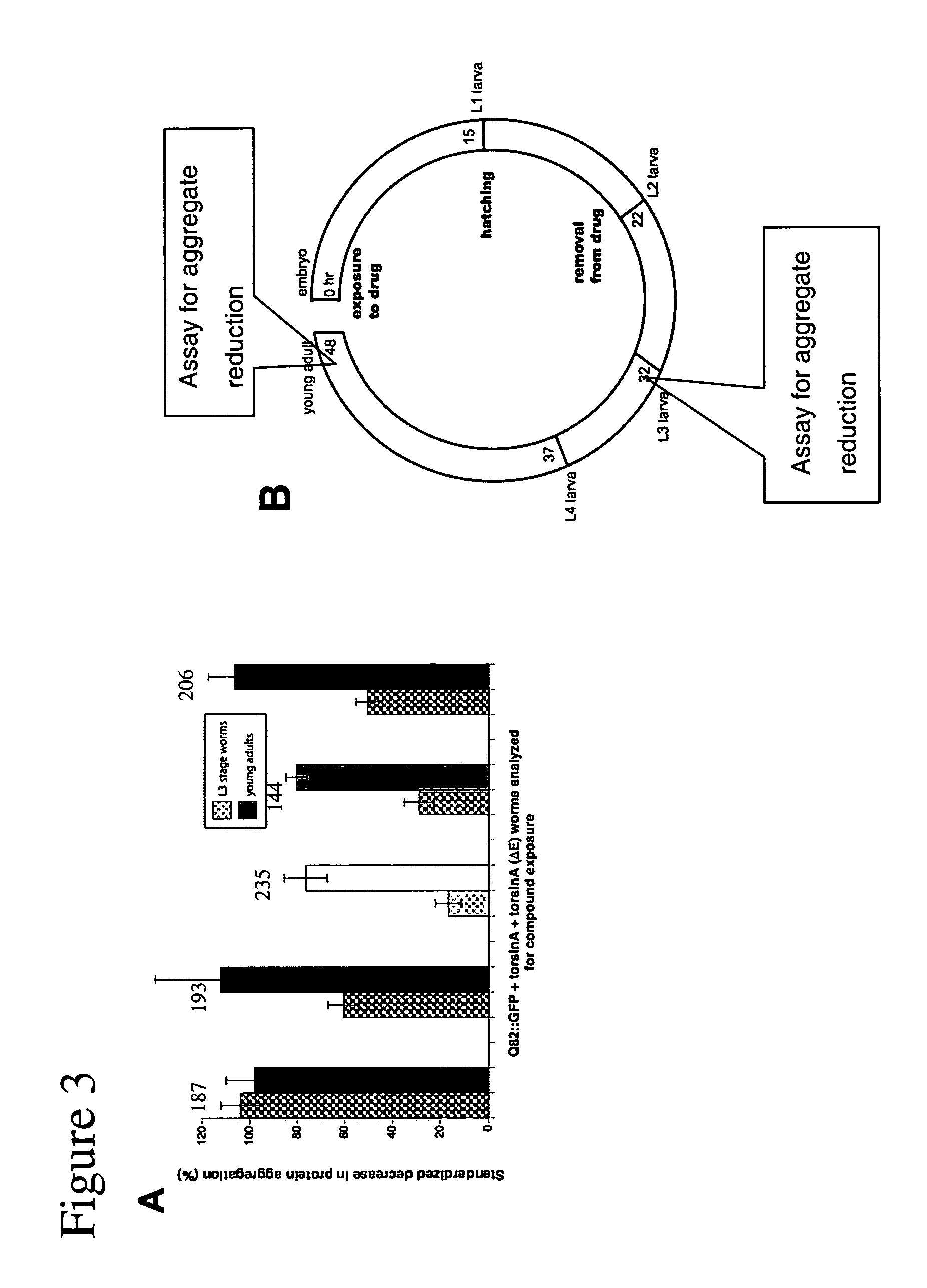Methods of using small molecule compounds for neuroprotection
a small molecule, neuroprotective technology, applied in the direction of heterocyclic compound active ingredients, biocide, drug compositions, etc., can solve the problems of further neuronal loss, enzyme dysfunction, and affecting the life of millions of individuals each year, so as to prevent neuronal death and reduce protein misfolding or aggregation.
- Summary
- Abstract
- Description
- Claims
- Application Information
AI Technical Summary
Benefits of technology
Problems solved by technology
Method used
Image
Examples
example 1
Screening a Small Molecule Library Using C. elegans Models of Protein Misfolding and Aggregation
[0127]C elegans nematodes were grown at 20° C. on NGM plates as described by Brenner (Brenner, Genetics, 1974, 77: 71-94). Several transgenic C. elegans lines were used for primary screens of the Prestwick small molecule library. A transgenic worm line expressing Punc-54::Q82-GFP; with both wild type (“wt”) (Punc=54: :torsinA) or mutant (Punc-54::torsinA(ΔE)). Torsin-A expresses a phenotype that results in visible protein aggregation under fluorescent microscope. Transgenic worms were plated on drug plates and progeny were studied for a return to soluble protein.
[0128] Drugs were administered to C. elegans according to a standard procedure (Rand and Johnson, Methods Cell Biol, 1995, 48: 187-204), by mixing the solubilized drug with the agar medium on which the worms are grown. This mode of administration allows the continuous exposure of worms to the drug.
[0129] Each drug was first dis...
example 2
Neuroprotection of Dopaminergic Neurons in C. elegans by Compounds Identified from the Prestwick Small Molecule Library
[0154] Previous studies have established that the “CEP” and “ADE” mechanosensory neurons in C. elegans undergo readily discernable neuronal degeneration after treatment with the dopamine-selective neurotoxin 6-OHDA (Nass et al, 2002). The toxicity of 6-OHDA is mediated through the formation of reactive oxygen species by the generation of hydrogen peroxide and hydroxide radicals via a nonenzymatic auto-oxidation process (Kumar et al., 1995; Foley and Riederer, 2000). After exposure to 6-OHDA, C. elegans dopamine neurons exhibit a characteristic dose dependent pattern of apoptotic cell death that was confirmed by ultrastructural analysis (Nass et al., 2002). This degeneration can be monitored in living animals by coexpressing with green fluorescent protein and categorized into three temporally and morphologically distinct stages, including neuronal process blebbing, ...
example 3
Protection of Neurons in a Model of Neurodegeneration Using a Transgenic C. elegans Overexpressing Tyrosine Hydroxylase
[0164] Overexpression of cat-2, the worm homologue for tyrosine hydroxylase, results in increased intraneuronal dopamine production and a characteristic loss of dopaminergic neurons in 75% of transgenic worms as compared to wild type (Cao et al., J Neurosci, 25(1):3801-3812). Co-expression of worm or human torsin proteins reduces the loss of dopaminergic neurons to a slight degree although neuronal degeneration is still present. The purpose of these experiments was to determine the effect of small molecule compounds in the Prestwick library in another different C. elegans model of neurodegeneration.
[0165] Worms were cultured using the same methods described above. A transgenic worm line expressing Pdat-1::CAT-2 expresses a phenotype that results in visible neurodegeneration at all developmental stages in an integrated line, in which only approximately 55% of 7 day...
PUM
| Property | Measurement | Unit |
|---|---|---|
| time | aaaaa | aaaaa |
| concentration | aaaaa | aaaaa |
| concentration | aaaaa | aaaaa |
Abstract
Description
Claims
Application Information
 Login to View More
Login to View More - R&D
- Intellectual Property
- Life Sciences
- Materials
- Tech Scout
- Unparalleled Data Quality
- Higher Quality Content
- 60% Fewer Hallucinations
Browse by: Latest US Patents, China's latest patents, Technical Efficacy Thesaurus, Application Domain, Technology Topic, Popular Technical Reports.
© 2025 PatSnap. All rights reserved.Legal|Privacy policy|Modern Slavery Act Transparency Statement|Sitemap|About US| Contact US: help@patsnap.com



